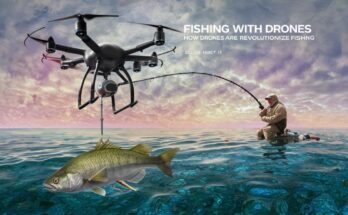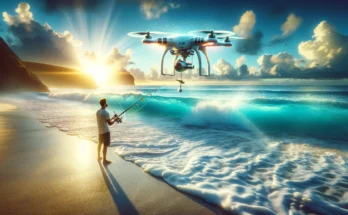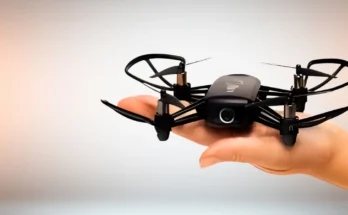Introduction to Underwater Drones with Claws
Underwater drones with claws represent modern technology within the field of marine exploration and intervention. These state-of-the-art devices, additionally called remotely operated cars (ROVs), are equipped with specialized claw mechanisms designed to control items and accumulate samples in underwater environments.
What is an underwater drone known as?
Underwater drones, frequently referred to as ROVs, are unmanned submersible vehicles managed remotely by means of operators at the surface. These drones are available in various sizes and styles, ranging from compact client fashions to large business-grade devices used in deep-sea exploration and business packages.
How do underwater drones with claws paintings?
Underwater drones with claws operate thru a combination of advanced engineering and robotics. They are prepared with thrusters for precise maneuverability and cameras for stay video feed, permitting operators to navigate and inspect underwater environments in real-time. The claw mechanism is typically controlled remotely, enabling the drone to grasp and manipulate objects with precision.
These drones are usually utilized in a wide variety of applications, along with underwater studies, marine salvage and inspection of underwater infrastructure, search and rescue operations, environmental tracking, and exploration of underwater ecosystems.
With their capability to access difficult-to-reach underwater locations and carry out elaborate tasks, underwater drones with claws are revolutionizing the manner we examine and engage with the sea depths. In the following sections, we can delve deeper into the application of these drones, discover the great options to be had within the market, and talk the blessings and prison concerns associated with their use.
Understanding the Utility of Underwater ROVs
Underwater remotely operated vehicles (ROVs) play a vital position in loads of industries and medical endeavors due to their versatility, reliability, and capacity to operate in hard underwater environments. Let’s discover the exclusive factors of their utility:
Who uses ROVs?
1. Oceanographic Research Institutes: ROVs are considerably used by oceanographic research institutes to study marine ecosystems, behavior underwater surveys, and collect records on ocean currents, biodiversity, and geological capabilities.
2. Oil and Gas Industry: In the oil and fuel industry, ROVs are hired for offshore exploration, underwater pipeline inspection, and upkeep tasks. These drones can perform at vast depths, allowing organizations to assess underwater infrastructure and identify capacity hazards.
3. Marine Salvage and Recovery: ROVs are valuable equipment for marine salvage operations, enabling salvage groups to discover and retrieve sunken vessels, cargo, or system from the sea ground. The claw mechanism on a few ROVs complements their functionality to grasp and lift gadgets from the seabed.
How deep can ROVs cross?
The intensity competencies of ROVs vary depending on their design and specs. While patron-grade ROVs may additionally have shallower intensity scores appropriate for recreational use, industrial-grade ROVs are built to resist severe pressures and may perform at depths exceeding several thousand meters. Some advanced ROVs are capable of exploring the inner most components of the sea, which includes trenches and hydrothermal vents, in which depths can reach over 10,000 meters.
How long do underwater drones closing?
The operational duration of underwater drones depends on factors together with battery capability, strength control structures, and the character of the project. While smaller customer-grade ROVs may have shorter battery existence ranging from 1 to 4 hours, large commercial ROVs can stay submerged for extended intervals, now and again up to 24 hours or extra, with the help of rechargeable battery packs or energy tethering systems.
Evaluating the Best Underwater Drones with Claws
When it comes to choosing the first-class underwater drone with claws, several elements need to be considered to make certain gold standard performance and functionality. Let’s discover those factors in element:
Review of QYSEA FIFISH V6S

The QYSEA FIFISH V6S is one of the leading underwater drones equipped with a claw mechanism, designed to meet the wishes of each expert and recreational users. Here’s a comprehensive evaluate of its capabilities:

- Depth Rating: The QYSEA FIFISH V6S boasts an excellent depth score of one hundred meters, permitting users to discover a extensive range of underwater environments with ease.
- Claw Mechanism: One of the standout features of this underwater drone is its incorporated claw mechanism, which allows customers to comprehend and manipulate objects underwater with precision. Whether it is accumulating samples for medical studies or retrieving lost gadgets, the claw adds a new size of capability to the drone.
- 4K UHD Camera: Equipped with a excessive-decision 4K UHD digital camera, the QYSEA FIFISH V6S can provide stunning underwater footage and live video streaming in real-time. The camera’s wide-angle lens offers panoramic views of the underwater global, allowing users to seize each detail with readability.
- Advanced Maneuverability: With six thrusters and omnidirectional manage, the QYSEA FIFISH V6S gives unparalleled maneuverability and stability underwater. Whether navigating thru tight spaces or exploring complex terrain, users can depend upon the drone’s unique manage and responsiveness.
- Long Battery Life: The drone features a high-ability battery that gives extended operational time, permitting users to maximize their underwater exploration periods without interruption. Additionally, the battery is easily swappable, ensuring minimum downtime between dives.
- User-Friendly Interface: The QYSEA FIFISH V6S comes with intuitive software program and a user-friendly interface, making it smooth for each newbie and skilled customers to function the drone effectively. With capabilities consisting of auto-stabilization and customizable manage settings, users can cognizance on capturing lovely photos without stressful approximately technical complexities.

In summary, the QYSEA FIFISH V6S sticks out as a top choice for underwater exploration and intervention, way to its superior functions, dependable overall performance, and flexible claw mechanism. Whether you are a professional researcher, marine fanatic, or commercial operator, this underwater drone offers the gear you need to unencumber the mysteries of the underwater global.
Exploring the Benefits and Legality
Underwater drones with claws offer several advantages throughout various industries and packages, however it is essential to recognize the prison considerations related to their use. Let’s delve into the advantages and prison factors:
What are the benefits of using underwater drones with claws?
- Efficient Data Collection: Underwater drones geared up with claws streamline records series techniques by allowing researchers and operators to retrieve samples, conduct inspections, and collect facts from underwater environments extra correctly. This efficiency results in quicker decision-making and progressed productivity in numerous fields inclusive of marine research, environmental monitoring, and infrastructure inspection.
- Cost-Effective Solutions: Compared to conventional techniques of underwater exploration and intervention, the usage of drones with claws can notably lessen prices related to manned missions, equipment deployment, and exertions-in depth tasks. The potential to perform tasks remotely and autonomously minimizes the want for human intervention underwater, resulting in value financial savings for corporations and companies.
- Enhanced Safety: By utilizing underwater drones with claws, operators can mitigate dangers related to human divers’ protection in hazardous or hard underwater conditions. Drones can access restrained areas, depths, or environments where it may be unsafe or impractical for humans to operate, consequently minimizing the capability for accidents or accidents.
- Environmental Preservation: Underwater drones with claws play a crucial role in environmental conservation efforts via facilitating studies, monitoring, and safety of marine ecosystems. These drones can gather records on water quality, marine life, and habitat situations without disturbing sensitive underwater environments, contributing to the maintenance and sustainable management of marine sources.
Are underwater drones with claws felony for private use?
The legality of working underwater drones with claws for personal use varies depending on factors along with region, policies, and intended use. While leisure customers may also experience the usage of drones for activities which includes underwater photography, exploration, or hobbyist tasks, positive restrictions and regulations may additionally apply, particularly in sensitive or covered marine areas.

It’s important for individuals to familiarize themselves with neighborhood laws, guidelines, and lets in governing the use of drones in their respective areas. Additionally, customers ought to adhere to hints and great practices for accountable drone operation, which include respecting wildlife, heading off interference with maritime sports, and ensuring compliance with privacy laws.
By understanding and complying with legal requirements, users can enjoy the benefits of underwater drones with claws at the same time as promoting safety, environmental stewardship, and responsible use of marine assets.
In summary, underwater drones with claws provide a wide range of blessings across industries and applications, from improving performance and safety to promoting environmental conservation. However, it’s important for customers to navigate the legal landscape and cling to rules governing their operation, making sure accountable and moral use of this transformative era.
Conclusion:
In conclusion, underwater drones with claws represent a remarkable fusion of technology and innovation, offering unprecedented capabilities for exploration, research, and intervention in underwater environments. From their ability to maneuver with precision and gather data efficiently to their role in enhancing safety and environmental conservation efforts, these drones have revolutionized various industries and scientific endeavors.
However, it’s essential for users to navigate the legal considerations associated with their operation, ensuring compliance with regulations and promoting responsible use of this transformative technology.
As underwater drones continue to evolve and advance, they hold immense potential to further our understanding of the ocean depths and contribute to the sustainable management of marine resources. By harnessing the benefits of underwater drones with claws while adhering to ethical and legal standards, we can unlock new frontiers of discovery and ensure a brighter future for our oceans.
FAQs
-
What are underwater drones with claws, and how do they work?
- Underwater drones with claws, also known as remotely operated vehicles (ROVs), are submersible vehicles equipped with specialized claw mechanisms for manipulating objects underwater. They operate through remote control, allowing operators on the surface to navigate the drone and control its claw to grasp and manipulate objects with precision.
-
What are the main applications of underwater drones with claws?
- Underwater drones with claws are utilized in a variety of industries and applications, including marine research, environmental monitoring, infrastructure inspection, marine salvage, search and rescue operations, and underwater exploration. Their versatility and maneuverability make them invaluable tools for tasks that require access to underwater environments and the manipulation of objects.
-
What features should I look for when selecting an underwater drone with claws?
- When choosing an underwater drone with claws, consider factors such as depth rating, claw mechanism functionality, camera quality, battery life, maneuverability, user interface, and software capabilities. Look for drones that meet your specific needs and requirements, whether for professional use, recreational exploration, or commercial applications.
-
Are underwater drones with claws legal for personal use?
- The legality of operating underwater drones with claws for personal use varies depending on location, regulations, and intended use. While recreational users may enjoy using drones for activities such as underwater photography or exploration, it’s essential to familiarize yourself with local laws, regulations, and permits governing drone operation in your area.
-
How deep can underwater drones with claws go?
- The depth capabilities of underwater drones with claws vary depending on their design and specifications. While consumer-grade drones may have shallower depth ratings suitable for recreational use, industrial-grade drones can operate at significant depths, sometimes exceeding several thousand meters. It’s important to choose a drone with a depth rating that matches your intended application and environment.
-
What are the benefits of using underwater drones with claws?
- Underwater drones with claws offer numerous benefits, including efficient data collection, cost-effective solutions, enhanced safety, and environmental preservation. By streamlining underwater operations, minimizing risks to human divers, and facilitating research and conservation efforts, these drones contribute to advancements in various industries and scientific endeavors.




